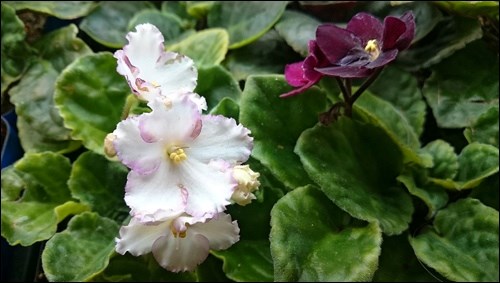Most gardeners are hopelessly addicted to seeing if “it will grow.” One of my favourite Prairie Master Gardeners is also a lover of growing African violets. She currently has 17 newly started African violets happily sitting under grow lights. These were part of a project to have some plants available for a recent class. The supply source for those 17 come from eight or 10 mature plants hosting blooms of purple, purple edged with white, pink, deep rose, light blue, ruffled white. African violets, genus Saintpaulia, are what one writer called “the perfect houseplant.”
African violets bloom year round with no specific flowering season, which is probably why they are considered perfect houseplants. But there is more to the story. They are of tropical origin and so are able to tolerate, thrive even, in heated houses. They have thick hairy leaves that protect them against water loss; they can live with the lower winter light levels and do not want even the direct sunlight of January days. If you keep your house at a comfortable temperature for you, your African violet will also be comfortable. They prefer slightly cooler nights, and they are woefully easy to propagate.
Care of African violets is simple. The growing mix, which can be a peat-based houseplant mix, should be slightly damp. Wait until the soil is dry to the touch before watering. The only way I have killed African Violets is by overwatering or potting them in a pot without drainage holes. A balanced fertilizer, 20-20-20 or 7-7-7 in the amounts of 1/8 tsp per two litres of water can be used with each watering, about once a week.
African violets can tolerate lower light levels than many other flowering plants but bright light is needed for flowering. Sunny south or west windows are too bright and will cause leaf burn. Even our low light in the winter can sometimes be too bright. The plants are happiest on an east or north window but watch for cold drafts in the winter time. Windows are not necessary for successful growing and flowering. The current location of those happy parents is in a house with no window sills and limited east window exposure.
The plants are cycled between grow lights and wherever a blooming plant is needed as they come into bloom. Ordinary florescent tubes, one warm white and one cool white, work just fine. Mature plants should be at least 10 inches away from the light while started cuttings can be six to eight inches. If the plant is too close to the light, the growth will be very dense, compact, and bleached out. Like any other plant, violets will tell you if they are lacking light. The leaves will turn toward the light and a long stem develops. If the light source is not directly overhead, turning the plant a quarter turn each time you water it will keep the plant balanced.
A large part of the charm of African violets is that they seem to attract few pests or diseases. Mealy bugs are the most likely pests and they appear on the undersides of leaves and at leaf axils. Dabbing them with a cotton swab dipped in rubbing alcohol works but it may be easiest to simply start a new plant from a leaf cutting which you have carefully cleaned. African violets do best in ceramic or plastic pots. They do not like the salts which develop over time in clay pots and any leaves touching the pot rim will wilt and rot.
Propagation is simple. Break off a healthy leaf, cut the stem at a 45 degree angle, and stick in water until roots form. Yes, I know the books talk about sterilized potting soil. I don't bother. Once roots are formed, the leaf is planted, roots and all, in a small pot and set under grow lights. Within a few weeks, the first baby plant will emerge. Usually within 3-4 weeks you will have anywhere from 2-6 baby plants poking up around the leaf stem. When the plantlets are about half way up the leaf stem, separate the plantlets so there is one stem with attached roots. Pot these into small containers (individual yogurt cartons with holes poked in the bottom work fine) and set them back under the grow lights. Often within 8-10 months, they will flower.
— Hanbidge is a horticulturist with the Saskatoon School of Horticulture and can be reached at 306-931-GROW(4769); by email at growyourfuture@gmail.com or check out our website at saskhort.com



